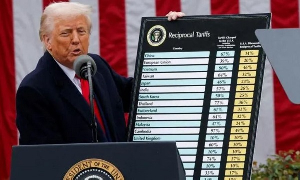Akwamu (also called Akwambo) was a state set up by Akan people (in present-day Ghana) that flourished in the 17th and 18th centuries. The Akwamus migrated from the Southern Sudan to Swedru and then later to Twifu Herman where they created a black stool and named it Amanpon gua.
To make the stool more powerful they needed a human being for some ritual, wherefore, on Kofi Akoto, the son of Obaapanin Yaa Ansaa voluntarily offered himself to be sacrificed for that purpose.
After the purification rites with the blood of Kofi Akoto, to the glory and honour of the family to which Kofi Akoto belonged, that is the Yaa Ansaa Royal Family, the said family became the custodians of the said black stool and all duties and authority in respect of the said stool were vested in the Yaa Ansaa Royal Family.
The Yaa Ansaa Family belongs to the Aduana clan and it was agreed that it was only from the Yaa Ansaa’s Family that a chief of Akwamu could be nominated, elected and enstooled.
In the year 1500 at Herman, the first Chief of Akwamu, Nana Agyen Kokobo from the Yaa Ansaa Family was enstooled. Successive chiefs from the Yaa Ansaa Royal Family took over the throne and led the people of Akwamu through the migrations to the present place of settlement of the banks of the River Volta, in the year 1733.
Out of the twenty nine (29) chiefs of Akwamu who have mounted the black stool, only two (2) of them have come from the Yaa Botwe Family of Aboabo and the two chiefs from Aboabo had been so as a result of shortfall of legible candidates from the Yaa Ansaa Family at that time. Those two chiefs were Nana Kwafo Akoto Okofroboo (1866 – 1882) and Odeneho Kwafo Akoto II (1937 – 1992).
Any other chief, not from the Yaa Ansaa family but who has ascended the black stool had done so with the consent of the Yaa Ansaa Family and as a result of the shortfall of legible candidates from the Yaa Ansaa Family.
LIST OF AKWAMU PARAMOUNT CHIEFS FROM1505-1992
Otumfuo Agyen Kokobo ”'(Yaa Ansaa Royal)”’
|1505–1520
|-
|Otumfuo Ofosu Kwabi ”'(Yaa Ansaa Royal)”’
|1520–1535
|-
|Otumfuo Oduro ”'(Yaa Ansaa Royal)”’
|1535–1550
|-
|Otumfuo Addow ”'(Yaa Ansaa Royal)”’
|1550–1565
|-
|Otumfuo Akoto I ”'(Yaa Ansaa Royal)”’
|1565–1580
|-
|Otumfuo Asare ”'(Yaa Ansaa Royal)”’
|1580–1595
|-
|Otumfuo Akotia ”'(Yaa Ansaa Royal)”’
|1595–1610
|-
|Otumfuo Obuoko Dako ”'(Yaa Ansaa Royal)”’
|1610–1625
|-
|Ohemmaa Afrakoma ”'(Yaa Ansaa Royal)”’
|1625–1640
|-
|Otumfuo Ansa Sasraku I ”'(Yaa Ansaa Royal)”’
|1640–1674
|-
|Otumfuo Ansa Sasraku II ”'(Yaa Ansaa Royal)”’
|1674–1689
|-
|Otumfuo Ansa Sasraku III ”'(Yaa Ansaa Royal)”’
|1689–1699
|-
|Otumfuo Ansa Sasraku IV (Addo) ”'(Yaa Ansaa Royal)”’
|1699–1702
|-
|Otumfuo Akonno Panyin ”'(Yaa Ansaa Royal)”’
|1702–1725
|-
|Otumfuo Ansa Kwao ”'(Yaa Ansaa Royal)”’
|1725–1730
|-
|Otumfuo Akonno Kuma (Regent)
|1730–1744
|-
|Otumfuo Opoku Kuma ”'(Yaa Ansaa Royal)”’
|1744–1747
|-
|Otumfuo Darko Yaw Panyin ”'(Yaa Ansaa Royal)”’
|1747–1781
|-
|Otumfuo Akoto Panyin ”'(Yaa Ansaa Royal)”’
|1781–1835
|-
|Otumfuo Dako Yaw Kuma ”'(Yaa Ansaa Royal)”’
|1835–1866
|-
|Otumfuo Kwafo Akoto I (Okorfroboo) ”'(Regent)’”
|1866–1882
|-
|Otumfuo Akoto Ababio (Kwame Kenseng) ”'(Yaa Ansaa Royal)”’
|1882–1887
|-
|Otumfuo Akoto Ababio II (Okra Akoto) ”'(Yaa Ansaa Royal)”’
|1887–1909
|-
|Otumfuo Akoto Kwadwo (Mensa Wood) ”'(Yaa Ansaa Royal)”’
|1909–1910
|-
|Otumfuo Akoto Ababio III (Emmanuel Asare) ”'(Yaa Ansaa Royal)”’
|1910–1917
|-
|Otumfuo Ansa Sasraku V (Kwabena Dapaa) ”'(Yaa Ansaa Royal)”’
|1917–1921
|-
|Otumfuo Akoto Ababio IV (Emmanuel Asare) ”'(Yaa Ansaa Royal)”’
|1921–1937
|-
Odeneho Kwafo Akoto II (Kwame Ofei) (Regent)
|1937–1992
The above history of the Akwamu Amanpon egua (Black stool) proves beyond reasonable doubt that the Yaa Ansaa Royal Family are the sole owners of the Akwamu Black stool
Opinions of Wednesday, 3 June 2020
Columnist: Benjamin Asamoah















